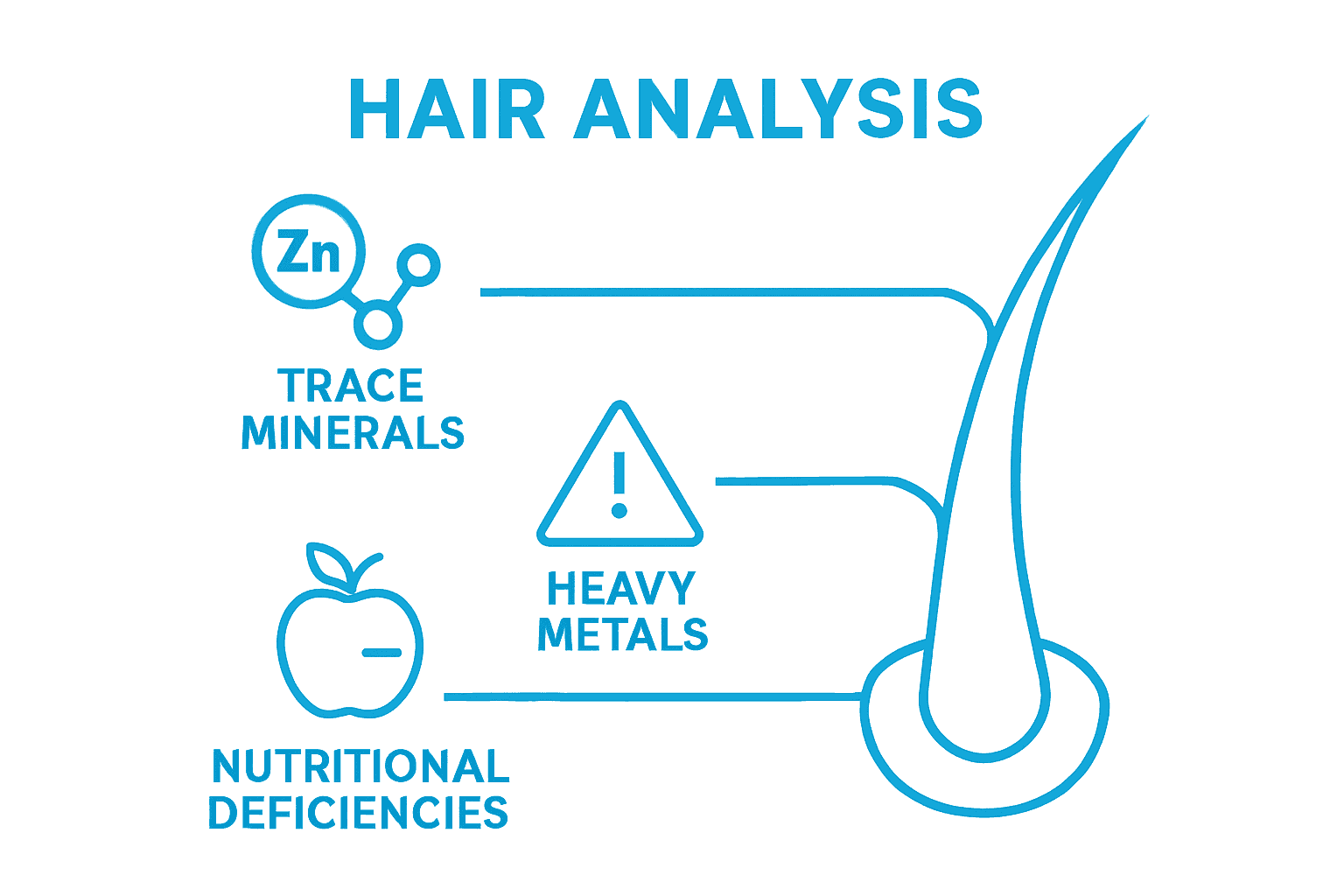Blog
Learning Materials
Understanding Hair Analysis: Insights for Healthy Hair
Updated: October 2, 2025

Hair analysis might sound like something only laboratories care about, but its reach goes way further than just science. Imagine this: a single strand of hair can capture up to one month's worth of health history for every centimeter. Most people think blood tests tell the full story, yet hair quietly holds a detailed record of nutritional changes, toxins, and even stress that regular checkups often miss.
Table of Contents
- What Is Hair Analysis And Why Is It Important?
- How Hair Analysis Works: The Science Behind It
- Key Concepts Of Hair Analysis: What To Know
- Applications Of Hair Analysis In Personal Care
- Understanding The Benefits Of Hair Analysis For Hair Health
Quick Summary
| Takeaway | Explanation |
|---|---|
| Hair analysis reveals health insights | Analyzing hair samples uncovers information about nutritional status, metabolic processes, and toxin exposure. |
| Segmental analysis tracks changes over time | By examining various hair segments, professionals can monitor changes in nutrient levels and environmental exposures. |
| Personalized care based on analysis | Results guide individualized hair care product selection and nutritional interventions for optimal hair health. |
| Longitudinal data offers unique perspective | Hair provides a historical record of metabolic activities, making it a valuable tool for long-term health assessments. |
| Advanced techniques ensure accurate results | Sophisticated methodologies like spectrometry are used to analyze hair samples for precise elemental composition. |
What is Hair Analysis and Why is it Important?
Hair analysis is a sophisticated diagnostic technique that goes beyond surface-level understanding of hair health. By examining hair samples, professionals can uncover intricate details about an individual's overall wellness, nutrient levels, and potential exposure to environmental toxins.
The Science Behind Hair Analysis
At its core, hair analysis involves examining a small hair sample to detect and measure various elements, minerals, and potential contaminants stored within the hair shaft. Research from the National Institutes of Health reveals that hair can serve as a remarkable "biological recorder" of an individual's health history, capturing information about nutritional status, metabolic processes, and potential environmental interactions.
The process works through advanced scientific methods that break down hair samples and analyze their chemical composition. Key aspects of this analysis include:
- Measuring trace mineral concentrations
- Detecting potential heavy metal exposures
- Assessing nutritional deficiencies
- Tracking long-term metabolic patterns
Practical Applications and Importance
Understanding hair analysis provides profound insights into personal health. By examining the microscopic details within hair strands, individuals can gain comprehensive information about their physiological state. Learn more about our comprehensive hair health analysis to see how advanced diagnostic techniques can transform your approach to wellness.
Hair analysis proves valuable across multiple domains:
- Medical Diagnostics: Identifying potential nutritional imbalances
- Environmental Health: Detecting exposure to toxic substances
- Personalized Nutrition: Developing targeted health interventions
While traditional medical tests provide immediate snapshots of health, hair analysis offers a unique longitudinal perspective.
The following table compares traditional medical tests with hair analysis to highlight their differences and complementary roles in health assessment.
| Method | Timeline of Information | Key Focus Areas | Sample Type | Unique Advantage |
|---|---|---|---|---|
| Traditional Medical Tests | Immediate (current state) | Blood chemistry, short-term biomarkers | Blood, urine | Fast results for acute or recent conditions |
| Hair Analysis | Longitudinal (historical trends) | Nutritional status, toxin exposure | Hair strand | Tracks changes and exposures over weeks/months |
How Hair Analysis Works: The Science Behind It
Hair analysis represents a complex scientific procedure that transforms a simple hair strand into a comprehensive health diagnostic tool. The intricate process involves multiple sophisticated techniques that extract and interpret valuable biochemical information stored within hair tissue.
Laboratory Preparation and Sample Processing
Research from cellular biology experts demonstrates that hair samples undergo meticulous preparation before analysis. Specialists carefully clean and process hair strands to eliminate potential external contamination, ensuring the most accurate results. The preparation involves:
- Washing hair samples with specialized solutions
- Cutting samples into precise segments
- Utilizing advanced decontamination protocols
- Preserving sample integrity throughout processing
Scientists employ spectroscopic techniques like atomic absorption spectrometry and inductively coupled plasma mass spectrometry to break down hair samples at a molecular level.
These methods allow researchers to detect minute quantities of elements and compounds with extraordinary precision.
Advanced Analytical Techniques
The core of hair analysis lies in its ability to reveal a biochemical timeline within each hair strand. By examining different hair segments, professionals can track changes in mineral composition, toxic metal exposure, and nutritional status over extended periods. Check out our comprehensive hair analysis test guide to understand the depth of insights available.
Analytical methods focus on several critical parameters:

- Elemental Composition: Measuring trace minerals and heavy metals
- Metabolic Markers: Identifying potential nutritional deficiencies
- Toxicological Screening: Detecting environmental chemical exposures
Interpreting Complex Data
Transforming raw scientific data into meaningful health insights requires advanced computational algorithms and expert interpretation. Specialists analyze the collected information against established biochemical baselines, creating personalized health profiles that reveal potential underlying conditions and metabolic patterns.
By mapping the microscopic landscape of a hair strand, hair analysis provides a unique window into an individual's physiological history, offering unprecedented insights into long-term health trends and potential environmental interactions.
Key Concepts of Hair Analysis: What to Know
Hair analysis is a nuanced scientific approach that requires understanding several critical concepts to interpret results accurately. While complex, these fundamental principles help transform raw data into meaningful health insights that can guide personal wellness strategies.
Segmental Analysis and Temporal Tracking
Research from clinical biochemistry experts reveals a groundbreaking technique called segmental analysis, which allows professionals to examine different hair segments and track changes over time. By cutting hair into precise sections, scientists can create a biochemical timeline revealing exposure patterns and metabolic shifts.
Key aspects of segmental analysis include:
- Documenting historical exposure to minerals
- Tracking nutritional changes
- Identifying potential environmental interactions
- Constructing a comprehensive metabolic profile
Understanding Hair Growth and Chemical Incorporation
Hair growth is not just a cosmetic process but a complex biochemical mechanism that captures and stores critical health information. Average hair growth occurs at approximately 1 cm per month, which means each centimeter represents roughly 30 days of metabolic activity. Learn more about understanding your hair health to gain deeper insights into this intricate process.
Important considerations in chemical incorporation include:
- Growth Rate: Determines the temporal resolution of analysis
- Metabolic Interaction: How nutrients and toxins integrate into hair structure
- Individual Variations: Differences in absorption and retention
Interpreting Analytical Results
Successful hair analysis goes beyond raw data collection. Specialists must consider multiple factors when interpreting results, including individual physiology, environmental exposures, and potential external contamination. The goal is to create a holistic understanding of an individual's health trajectory.
Critical interpretation factors encompass:
- Comparative baseline measurements
- Individual metabolic variations
- Potential confounding environmental factors
- Comprehensive health history
By understanding these key concepts, individuals can appreciate the depth and complexity of hair analysis as a powerful diagnostic tool for long-term health monitoring and personalized wellness strategies.
This table provides an overview of the main features assessed during hair analysis to organize key characteristics the procedure examines.
| Feature Assessed | Purpose | What It Reveals |
|---|---|---|
| Trace Mineral Levels | Evaluate nutritional status | Essential micronutrient sufficiency or deficiencies |
| Heavy Metal Contaminants | Detect environmental exposure | Possible absorption of harmful substances |
| Structural Integrity | Assess hair strength and resilience | Presence of damage or weak points in the hair shaft |
| Metabolic Markers | Track long-term health patterns | Shifts in metabolism, physiological changes |
| Genetic Predispositions | Understand inherent hair qualities | Insights into vulnerabilities or strengths |
Applications of Hair Analysis in Personal Care
Hair analysis has emerged as a transformative tool in personal care, offering unprecedented insights into hair health beyond traditional diagnostic methods. By revealing intricate details about an individual's hair composition, this advanced technique enables more targeted and personalized care strategies.
Personalized Hair and Scalp Assessment
Research on cosmetic treatments demonstrates that hair analysis can provide comprehensive evaluations of hair health, helping individuals understand their unique hair characteristics. This approach goes far beyond simple visual inspection, diving deep into the biochemical composition of hair strands.
Key assessment areas include:
- Determining individual hair structure
- Identifying potential nutritional deficiencies
- Evaluating environmental damage
- Understanding genetic predispositions
Product Selection and Treatment Optimization
Hair analysis enables precise product recommendations tailored to an individual's specific hair needs. By understanding the exact mineral composition, protein levels, and potential chemical exposures, consumers can make more informed choices about hair care products. Check out our expert tips for stronger hair growth to learn how personalized insights can transform your hair care routine.
Important considerations for product selection include:
- Mineral Balance: Matching products to individual trace element needs
- Damage Repair: Targeting specific types of hair stress
- Preventative Care: Addressing potential future hair health risks
Monitoring Long-Term Hair Health
Beyond immediate care strategies, hair analysis provides a powerful tool for tracking hair health over time. By establishing baseline measurements and conducting periodic assessments, individuals can:
- Track the effectiveness of hair care interventions
- Monitor potential environmental impacts
- Understand long-term nutritional influences
- Develop proactive hair maintenance strategies
This approach transforms hair care from a reactive to a proactive discipline, empowering individuals to make informed decisions about their hair health based on scientific insights rather than generic recommendations.

Understanding the Benefits of Hair Analysis for Hair Health
Hair analysis emerges as a powerful diagnostic tool that transcends traditional hair care approaches, offering comprehensive insights into individual hair health. By examining the intricate biochemical landscape of hair strands, individuals can unlock a deeper understanding of their unique hair characteristics and potential wellness challenges.
Identifying Nutritional and Metabolic Insights
Research on micronutrient analysis reveals that hair analysis can detect subtle nutritional imbalances that significantly impact hair growth and quality. These insights go beyond surface-level observations, providing a molecular-level understanding of an individual's metabolic health.
Key nutritional benefits include:
- Detecting micronutrient deficiencies
- Understanding metabolic patterns
- Identifying potential dietary interventions
- Tracking long-term nutritional status
Comprehensive Hair Health Assessment
Hair analysis provides a holistic view of hair condition, exploring factors that traditional methods might overlook. Structural integrity, mineral composition, and environmental interactions become clear through sophisticated analytical techniques. Explore our guide to personalized hair health strategies to gain deeper insights into your unique hair profile.
Critical assessment areas encompass:
- Structural Damage: Identifying potential weak points
- Environmental Stress: Mapping external impact factors
- Genetic Predispositions: Understanding inherited hair characteristics
Preventative and Personalized Care Strategy
Beyond diagnostic capabilities, hair analysis empowers individuals to develop targeted, proactive hair care approaches. By understanding the precise biochemical composition of hair, people can:
- Select most appropriate hair care products
- Design personalized nutritional interventions
- Develop targeted treatment protocols
- Prevent potential future hair health issues
This scientific approach transforms hair care from a generic, one-size-fits-all model to a precision-driven, individualized strategy that addresses unique physiological needs and potential challenges.
Discover the Power of Personalized Hair Analysis with MyHair.ai
Are you struggling to understand the true reasons behind hair loss or slow growth? The article highlighted how hair analysis delivers deep biochemical insights to uncover nutritional deficiencies, track metabolic patterns, and spot environmental impacts. But turning this scientific knowledge into real results can feel overwhelming on your own.

Let MyHair.ai transform your new understanding into a personalized action plan. Upload a scan of your hair and let our AI-based technology decode your unique hair patterns. Get individual growth projections, spot hidden issues, and receive tailored product recommendations designed just for your needs. Ready for healthier hair? Get started with a detailed assessment today and take control of your hair journey. For a deeper look at how powerful analysis can benefit you, explore our comprehensive hair health insights and learn more about personalized hair health strategies. Your best hair begins with science—start your transformation now at MyHair.ai.
Frequently Asked Questions
What is hair analysis and how does it work?
Hair analysis is a diagnostic technique that examines hair samples to assess an individual's overall health, nutrient levels, and exposure to toxins. The process involves advanced scientific methods to measure trace minerals and detect potential contaminants stored within the hair shaft.
How can hair analysis help with hair health?
Hair analysis can identify nutritional deficiencies, assess environmental damage, and provide personalized care strategies. By understanding the biochemical composition of hair, individuals can make informed choices about their hair care products and routines.
What types of insights can I gain from hair analysis?
Hair analysis can reveal critical information such as nutritional status, metabolic patterns, and potential exposure to toxins. It also helps in tracking long-term changes in hair health and effectiveness of interventions.
Is hair analysis a good option for personalized hair care?
Yes, hair analysis offers a personalized approach to hair care by evaluating individual hair characteristics. It allows for targeted treatment strategies and informed product selection tailored to unique hair needs.
Recommended
- Understanding Hair Analysis for Hair Loss: What You Need to Know | MyHair | MyHair
- Understanding Hair Health: The Science Behind It | MyHair | MyHair
- Hair Analysis Test 2025: Discover Your Health Insights | MyHair | MyHair
- 5 Tips for Healthy Hair: Easy Steps for Shiny, Strong Locks | MyHair | MyHair